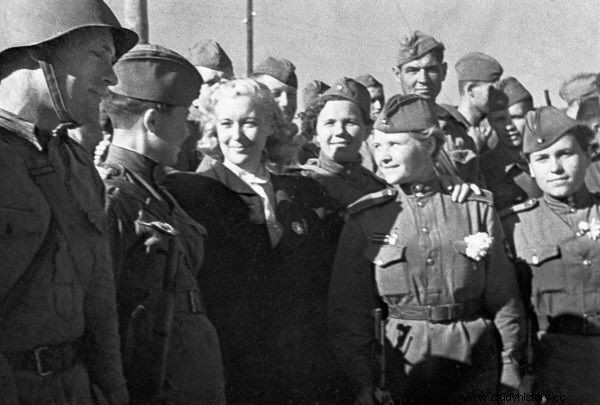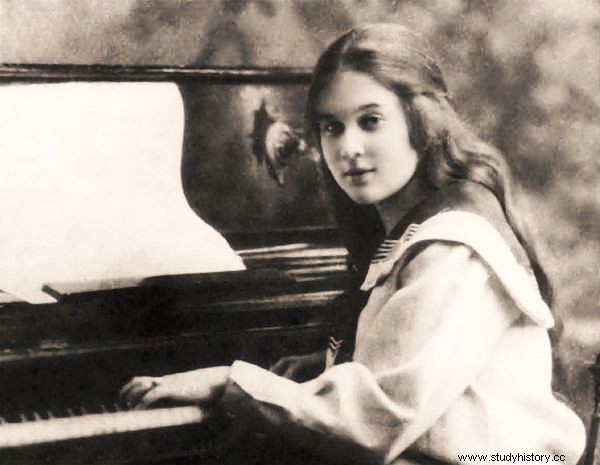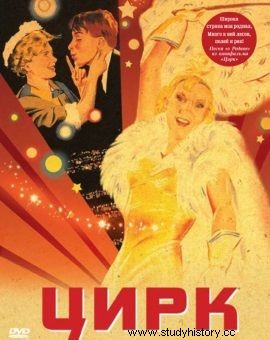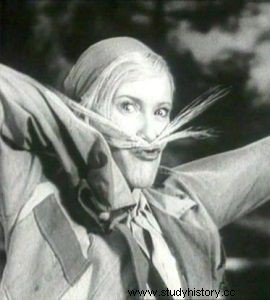Could sex symbols exist in a country where sex officially did not exist? Of course. We present a woman to whom the entire male population of Soviet Russia sighed. After her film debut, Stalin himself came up and promised to grant her every wish.
There comes a point in every woman's life when she has to admit how old she is. Lyubov Orlova had no problem with that. She kept saying she would never be more than thirty-nine.
In an effort to stay young, Orlova was the first Soviet actress to undergo plastic surgery. When we look at her photos, we see the face of a serious, mature woman, a bit too wide. She was compared to Marlena Dietrich, and the audience lost their minds to her. Perhaps that is why her colleagues hated her. Another famous Soviet actress, Faina Raniewska, even claimed that when Orłowa sings, she makes sounds as if someone was pissing into an empty bucket .
Chilling jokes

Lubov Orłowa in the film "Circus" (1936).
Lyubov, born in 1902, actually aged prematurely and even before the age of 30 had to be filmed with a camera with a stocking on so that no wrinkles are visible. This was how things were done before Photoshop.
In some of the photographs, the silhouette of Orłowa seems somewhat shapeless. Probably part of the blame for this lies with the harsh Soviet fashion of the 1930s and 1940s, with the ubiquitous boxy jackets and flared shoulders. In fact, the actress was very small and slender (158 cm tall and a waist 43 cm; for comparison, Marylin Monroe's measurements are 91-58-91 cm, with a height of 165 cm).
Apparently, Stalin once made a joke at a party that the star was too skinny. He added that for such neglect of Orłowa her husband should be punished by shooting. Considering how quickly it was possible to fall from the top to the bottom in the USSR, the heroes of such jokes were definitely not laughing.
Interestingly, some Soviet women tried by all means to achieve a figure in the image of an actress. They strove for it so intensely that psychiatrists coined an appropriate term for this phenomenon:"Orlova syndrome".

Orlov at a meeting with Soviet soldiers at the front in 1943. (photo published under the CCA SA 3.0 license, author:S. Kulishov)
In female fans in the last stage, the disease consisted of, among other things, adherence to a restrictive diet (including not eating bread and lard, popular in the USSR) and ... introducing herself as the star's sister.
Minor hoax of a big star
Orłowa, laughing on the screen, acted like a haughty matron in her life. She came from an old aristocratic family (from the same Orlovs who shook the Russian court under Tsarina Catherine), and her relative was Leo Tolstoy himself.
When she played, she was familiar, and at the same time distant and mysterious, which was extremely attractive. When Luba was walking down the street in Moscow, everyone was looking after her, and men who were unfamiliar were pulling their hats off their heads. At the same time, she had to watch out and hide her aristocratic roots all the time.
It was clearly stated in her official biography that she came from a family of servants, and this version is often featured in the bios until now. Orłowa perfected the details of her life story. She even came up with a fairy tale explaining why she had a book by Tolstoy with a personal dedication. She just wrote to a great writer once as a child and received a gift like this…
A sickly skimpy aristocrat?
She undoubtedly had talent. Already in childhood, one of the greatest singers in the history of opera, the great Shaliapin, foretold her acting career. She received a careful upbringing, knew several languages, could sing, dance, ride horses, fencing and played the piano perfectly (she graduated from music school, and then a conservatory). The October Revolution - to put it mildly - did not like people like her.
This article has more than one page. Please select another one below to continue reading.Attention! You are not on the first page of the article. If you want to read from the beginning click here.
As a teenager, Orłowa was sent to the countryside to her aunt, where she learned to work hard, including milking cows . She later used the skill she acquired at that time in her first box-office film "Wiesiołyje riebiata" - known in Poland as "The World Laughs" (1934) - playing the role of a ruddy milkwoman.

The young Lyubov was to become a pianist, instead she became a ... man's heart eater.
During meetings with admirers, the star was limited to a short recital. The formula was clearly defined and there was no question of asking questions from the audience. Orłowa's chauffeur also mentioned the actress's morbid stinginess . It manifested itself in that the big star of the screen, among other things, was mending her old torn gloves .
Difficult choices of the Soviet woman

Poster for the film "Cyrk" (1936). Aleksandrov directed it and Orłowa played the main role.
Lyubov Orlova experienced a great tragedy. Her first husband, an official Andrei Bierzin, was sent to a labor camp.
However, his wife did not share his fate, choosing a career instead of an uncertain love in the gulag. Her greatest acting successes were in the productions of her second husband, director Grigory Aleksandrov.
He made great films that perfectly suited Stalin's tastes and at the same time had the support of the Kremlin's court writer, Maxim Gorky.
He noticed Orłowa on the stage of a musical theater and admired her star beauty. He did not like the test shots, so the actress, ready for anything, arranged a dinner at the house of a mutual friend.
How to pick up a director?
The hostess had to come out in an emergency, and when she returned, Lyubov already had a role in the movie "Wiesiołyje riebiata". And when the shooting was over, she and the director were already a couple (and it was not prevented by the fact that Aleksandrov had a wife and a child) .

Orłowa never lost her spirits. This versatile actress, known, among others, from the hits "Świat się laughs", "Volga-Volga" (photo from the film) and "Circus", never lost touch with her audience.
The relationship was certainly more commercial than romantic. Additionally, Luba's second husband was that specific type of man who would not hesitate to report on his closest friend if he stood in the way of his success.
Apparently, there were years when Lyubov herself was afraid of her influential husband. On the screen, she strengthened her position with such hits as "Circus" (1936), "Volga, Volga" (1938), "Spring" (1947), "Meeting on Elba" (1949).
After the Second World War, lean years came for Orłowa. With Khrushchev's thaw, the tastes of the audience changed, and perhaps most of all the tastes of party apparatchiks.
The 1960 film-revue "Russian Souvenir" turned out to be a failure and Aleksandrov started working on a dacha in Vnukovo near Moscow, instead of directing.
Orlova traveled around the country at the same time with recitals, actually maintaining the house. She died of cancer in 1975. When she found out about her terminal illness, she said: I am absolutely not afraid of death. I got so tired of living ...
Sources:
Basic:
- A. Chort "Lubov" Orłowa "(sierija" Żyzn "zamieczatielnych peopleiej"), Mołodaja gwardija, 2007
- A.W.Romanow "Lubow 'Orłowa in iscussion and fertile", M., Iskusstwo, 1987
Complementary:
- Documentary film "Three loves of Orlova" ("Tri lubwi Lubowi Orłowoj", directed by Dmitrij Grachev, 2005)
